Impact of Climate Change on Drought Dynamics in the Ganale Dawa River Basin, Ethiopia
Abstract
1. Introduction
2. Materials and Methods
2.1. Study Area
2.2. Data Sources
2.3. Preprocessing and Model Selection
2.4. Variables and Indicators
2.5. Machine Learning Models
2.6. Model Evaluation
2.7. Drought Event Identification and Characterization
2.8. Trend Analysis
3. Results
3.1. Model Performance and Simulation
3.2. Feature Importance Analysis of Drought Drivers
3.3. Trends of Agricultural Drought Event Under Changing Climate
3.4. Trends of Hydrological Drought Event Under Changing Climate
3.5. Comparative Assessment of Agricultural and Hydrological Droughts
4. Discussion
5. Conclusions
Supplementary Materials
Author Contributions
Funding
Data Availability Statement
Acknowledgments
Conflicts of Interest
Appendix A
| No. | Model Name | Bias (Mean) | MAE | RMSE | Correlation |
|---|---|---|---|---|---|
| 1 | ACCESS-CM2 | 6.960652 | 38.86574 | 63.18939 | 0.567041 |
| 2 | ACCESS-ESM1-5 | 12.434621 | 44.09539 | 177.5348 | 0.056342 |
| 3 | CanESM5 | 1.762437 | 37.38088 | 61.17916 | 0.554218 |
| 4 | CMCC-CM2-SR5 | 4.778925 | 37.93013 | 60.70562 | 0.587652 |
| 5 | CMCC-ESM2 | 3.503034 | 37.11299 | 58.98753 | 0.609402 |
| 6 | CNRM-CM6-1 | 6.660561 | 37.77055 | 61.41667 | 0.598365 |
| 7 | CNRM-ESM2-1 | 13.143903 | 40.50308 | 107.4747 | 0.194299 |
| 8 | EC-Earth3 | 7.308516 | 38.51799 | 61.64838 | 0.588715 |
| 9 | EC-Earth3-Veg-LR | 8.611809 | 41.93283 | 69.9107 | 0.548529 |
| 10 | FGOALS-g3 | 7.395749 | 31.8351 | 49.17464 | 0.694103 |
| 11 | GFDL-CM4 | 64.282425 | 77.0667 | 123.3005 | 0.628898 |
| 12 | GFDL-ESM4 | 7.109607 | 35.71228 | 56.55272 | 0.629033 |
| 13 | GISS-E2-1-G | 5.12709 | 32.31053 | 51.04295 | 0.670756 |
| 14 | HadGEM3-GC31-LL | 6.313097 | 36.17872 | 58.61608 | 0.623518 |
| 15 | INM-CM4-8 | 8.294831 | 36.01581 | 57.65871 | 0.620639 |
| 16 | INM-CM5-0 | 9.19482 | 34.96757 | 55.70558 | 0.646184 |
| 17 | KACE-1-0-G | −6.747532 | 35.35808 | 58.27535 | 0.592231 |
| 18 | MIROC-ES2L | 5.645569 | 34.76069 | 54.5616 | 0.636779 |
| 19 | MPI-ESM1-2-HR | 5.684605 | 39.00647 | 62.39078 | 0.561792 |
| 20 | MPI-ESM1-2-LR | 8.544987 | 39.63353 | 72.1986 | 0.40411 |
| 21 | MRI-ESM2-0 | 9.470756 | 40.07164 | 64.74332 | 0.570024 |
| 22 | NorESM2-MM | 6.304193 | 41.11264 | 68.22092 | 0.529574 |
| No. | Model Name | Bias (Mean) | MAE | RMSE | Correlation |
|---|---|---|---|---|---|
| 1 | ACCESS-CM2 | −2.289328 | 2.416353 | 2.641831 | 0.930905 |
| 2 | ACCESS-ESM1-5 | −2.234697 | 2.367154 | 2.590915 | 0.931507 |
| 3 | CanESM5 | 1.397678 | 1.933708 | 2.287632 | 0.903075 |
| 4 | CMCC-CM2-SR5 | −2.313424 | 2.492536 | 2.750074 | 0.921308 |
| 5 | CMCC-ESM2 | −2.367283 | 2.478412 | 2.721961 | 0.928545 |
| 6 | CNRM-CM6-1 | −2.425368 | 2.522007 | 2.754718 | 0.930787 |
| 7 | CNRM-ESM2-1 | −2.221506 | 2.325528 | 2.521517 | 0.937738 |
| 8 | EC-Earth3 | −2.175069 | 2.357072 | 2.635449 | 0.921956 |
| 9 | EC-Earth3-Veg-LR | −2.3574 | 2.49982 | 2.770119 | 0.92263 |
| 10 | FGOALS-g3 | −2.397562 | 2.486235 | 2.693574 | 0.934719 |
| 11 | GFDL-CM4 | −2.443092 | 2.556329 | 2.795224 | 0.927497 |
| 12 | GFDL-ESM4 | −2.408446 | 2.525156 | 2.768332 | 0.927666 |
| 13 | GISS-E2-1-G | −2.323546 | 2.426377 | 2.635676 | 0.934761 |
| 14 | HadGEM3-GC31-LL | −2.177575 | 2.31413 | 2.53836 | 0.932567 |
| 15 | INM-CM4-8 | −2.3397 | 2.424634 | 2.602186 | 0.9395 |
| 16 | INM-CM5-0 | −2.433867 | 2.506937 | 2.696271 | 0.938043 |
| 17 | KACE-1-0-G | −2.267025 | 2.359743 | 2.557747 | 0.937759 |
| 18 | MIROC-ES2L | −2.485161 | 2.573102 | 2.783908 | 0.932989 |
| 19 | MPI-ESM1-2-HR | −2.30271 | 2.443056 | 2.700425 | 0.925888 |
| 20 | MPI-ESM1-2-LR | −2.282452 | 2.420713 | 2.657677 | 0.928723 |
| 21 | MRI-ESM2-0 | −2.510434 | 2.594334 | 2.81483 | 0.931516 |
| 22 | NorESM2-MM | −2.461188 | 2.573703 | 2.829793 | 0.925662 |
| Model | Variable | RMSE | R2 | MAE |
|---|---|---|---|---|
| Random Forest | SSMI | 0.0157 | 0.9513 | 0.0098 |
| SRI | 0.0255 | 0.8336 | 0.0064 | |
| XGBoost | SSMI | 0.0312 | 0.8078 | 0.0224 |
| SRI | 0.0327 | 0.7267 | 0.01 | |
| LightGBM | SSMI | 0.0332 | 0.7817 | 0.0241 |
| SRI | 0.0356 | 0.6758 | 0.011 | |
| CatBoost | SSMI | 0.0311 | 0.8096 | 0.0223 |
| SRI | 0.0327 | 0.7254 | 0.0101 | |
| MLP | SSMI | 0.0474 | 0.5568 | 0.0364 |
| SRI | 0.0526 | 0.2927 | 0.0197 | |
| LSTM | SSMI | 0.0574 | 0.7528 | 0.0384 |
| SRI | 0.0476 | 0.717 | 0.021 |


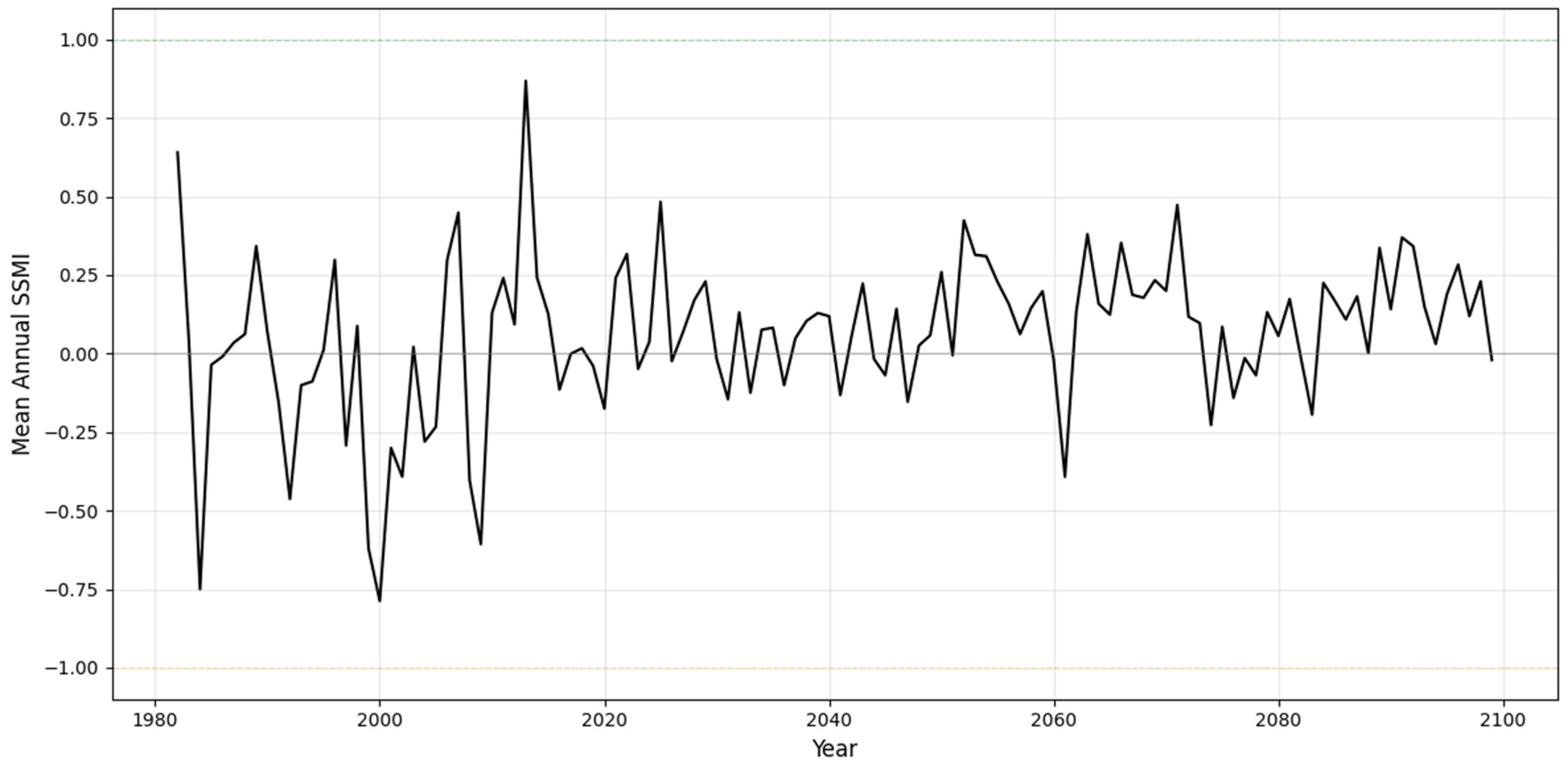
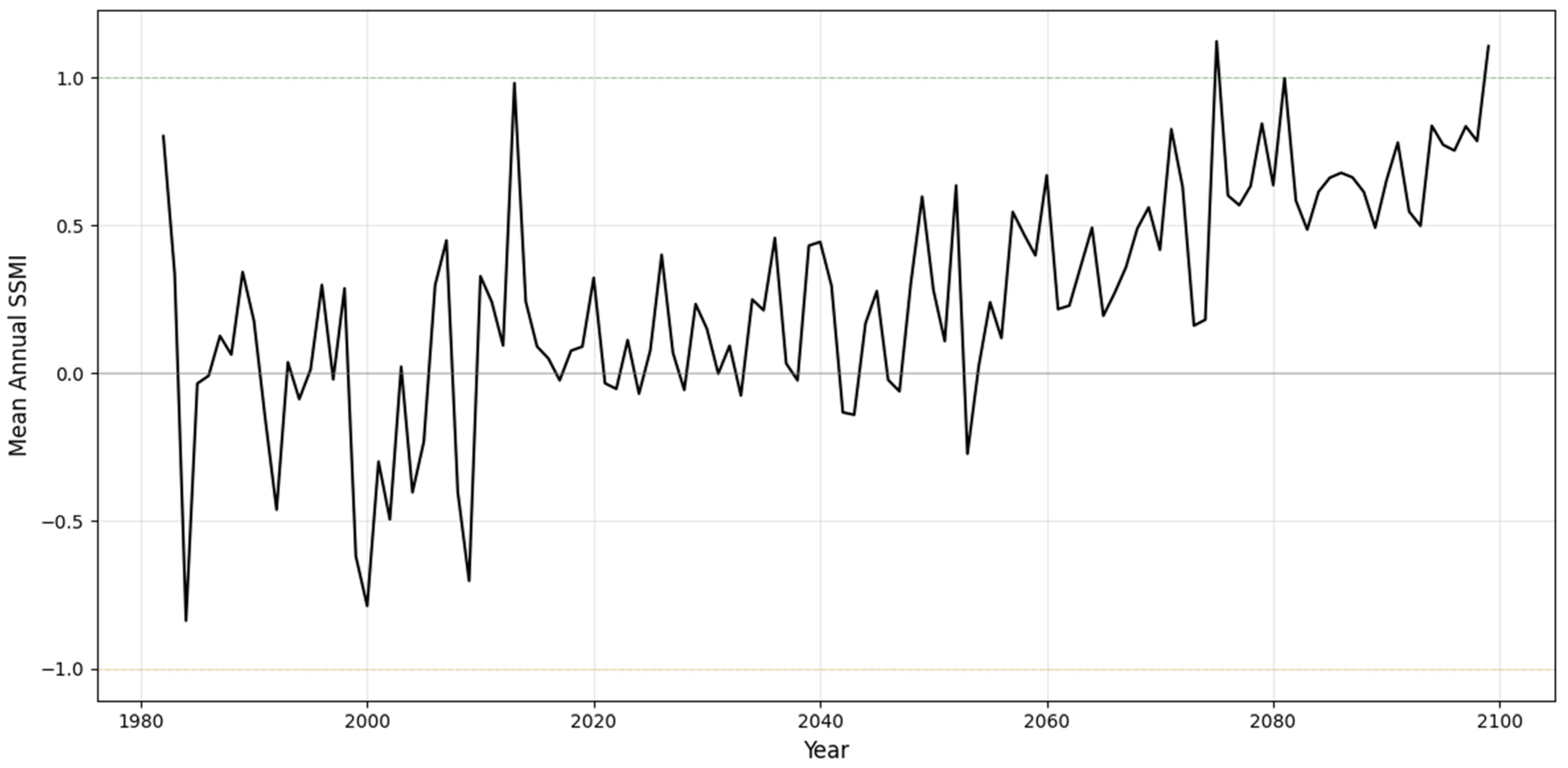


References
- Rahman, G.; Jung, M.-K.; Kim, T.-W.; Kwon, H.H. Drought impact, vulnerability, risk assessment, management and mitigation under climate change: A comprehensive review. KSCE J. Civ. Eng. 2025, 29, 100120. [Google Scholar] [CrossRef]
- IPCC. Summary for Policymakers. In Climate Change 2021: The Physical Science Basis; Contribution of Working Group I to the Sixth Assessment Report of the IPCC; Masson-Delmotte, V., Zhai, P., Pirani, A., Connors, S.L., Péan, C., Berger, S., Caud, N., Chen, Y., Goldfarb, L., Gomis, M.I., et al., Eds.; IPCC: Geneva, Switzerland, 2021. [Google Scholar] [CrossRef]
- Guha-Sapir, D.; Below, R.; Hoyois, P. EM-DAT: The Emergency Events Database. Université Catholique de Louvain (UCL), Centre for Research on the Epidemiology of Disasters (CRED). 2021. Available online: https://www.emdat.be/ (accessed on 12 December 2023).
- World Meteorological Organization (WMO). State of the Climate in Africa 2020; WMO-No. 1275; World Meteorological Organization (WMO): Geneva, Switzerland, 2021. Available online: https://library.wmo.int/index.php?lvl=notice_display&id=21930 (accessed on 12 December 2023).
- Lombe, P.; Carvalho, E.; Rosa-Santos, P. Drought dynamics in Sub-Saharan Africa: Impacts and adaptation strategies. Sustainability 2024, 16, 9902. [Google Scholar] [CrossRef]
- Gu, L.; Schumacher, D.L.; Fischer, E.M.; Slater, L.J.; Yin, J.; Sippel, S.; Chen, J.; Liu, P.; Knutti, R. Flash drought impacts on global ecosystems amplified by extreme heat. Nat. Geosci. 2025, 18, 709–715. [Google Scholar] [CrossRef]
- UN Water. The United Nations World Water Development Report 2021: Valuing Water. UNESCO. 2021. Available online: https://unesdoc.unesco.org/ark:/48223/pf0000375724 (accessed on 12 December 2023).
- Xu, F.; Qu, Y.; Bento, V.A.; Song, H.; Qiu, J.; Qi, J.; Wan, L.; Zhang, R.; Miao, L.; Zhang, X.; et al. Understanding climate change impacts on drought in China over the 21st century: A multi-model assessment from CMIP6. NPJ Clim. Atmos. Sci. 2024, 7, 32. [Google Scholar] [CrossRef]
- Fanta, S.S.; Yesuf, M.B.; Merkos, M.T.; Demissie, T.A. The spatio-temporal trend of climate and characterization of drought in Borana Zone, Ethiopia. Sci. Rep. 2025, 15, 4743. [Google Scholar] [CrossRef]
- Wang, L.; Wang, W.J.; Du, H.; Shen, X.; Wu, Z.; Ma, S.; Liu, Z.; Jiang, M. Was warming amplified under drought conditions across China in observations and future projections? Earths Future 2022, 10, e2021EF002614. [Google Scholar] [CrossRef]
- Gebrechorkos, S.H.; Taye, M.T.; Birhanu, B.; Solomon, D.; Demissie, T. Future changes in climate and hydroclimate extremes in East Africa. Earths Future 2023, 11, e2022EF003011. [Google Scholar] [CrossRef]
- Ayugi, B.; Dike, V.; Ngoma, H.; Babaousmail, H.; Mumo, R.; Ongoma, V. Future changes in precipitation extremes over East Africa based on CMIP6 models. Water 2021, 13, 2358. [Google Scholar] [CrossRef]
- Gebrechorkos, S.H.; Hülsmann, S.; Bernhofer, C. Analysis of climate variability and droughts in East Africa using high-resolution climate data products. Glob. Planet Change 2020, 186, 103130. [Google Scholar] [CrossRef]
- Jiang, J.; Zhou, T.; Qian, Y.; Li, C.; Song, F.; Li, H.; Chen, X.; Zhang, W.; Chen, Z. Precipitation regime changes in High Mountain Asia driven by cleaner air. Nature 2023, 623, 544–549. [Google Scholar] [CrossRef]
- Dinku, T.; Funk, C.; Peterson, P.; Maidment, R.; Tadesse, T.; Gadain, H.; Ceccato, P. Validation of the CHIRPS satellite rainfall estimates over eastern Africa. Q. J. R. Meteorol. Soc. 2018, 144, 292–312. [Google Scholar] [CrossRef]
- Eyring, V.; Bony, S.; Meehl, G.A.; Senior, C.A.; Stevens, B.; Stouffer, R.J.; Taylor, K.E. Overview of the coupled model intercomparison project phase 6 (CMIP6) experimental design and organization. Geosci. Model Dev. 2016, 9, 1937–1958. [Google Scholar] [CrossRef]
- Behzadi, F.; Javadi, S.; Yousefi, H.; Hashemy Shahdany, S.M.; Moridi, A.; Neshat, A.; Golmohammadi, G.; Maghsoudi, R. Projections of meteorological drought severity-duration variations based on CMIP6. Sci. Rep. 2024, 14, 5027. [Google Scholar] [CrossRef]
- Ukkola, A.M.; De Kauwe, M.G.; Roderick, M.L.; Abramowitz, G.; Pitman, A.J. Robust future changes in meteorological drought in CMIP6 projections despite uncertainty in precipitation. Geophys. Res. Lett. 2020, 47, e2020GL087820. [Google Scholar] [CrossRef]
- Su, B.; Huang, J.; Mondal, S.K.; Zhai, J.; Wang, Y.; Wen, S.; Gao, M.; Lv, Y.; Jiang, S.; Jiang, T.; et al. Insight from CMIP6 SSP-RCP scenarios for future drought characteristics in China. Atmos. Res. 2021, 250, 105375. [Google Scholar] [CrossRef]
- Almazroui, M.; Saeed, F.; Saeed, S.; Islam, M.N.; Ismail, M.; Klutse, N.A.B.; Siddiqui, M.H. Projected change in temperature and precipitation over Africa from CMIP6. Earth Syst. Environ. 2020, 4, 455–475. [Google Scholar] [CrossRef]
- Li, S.Y.; Miao, L.J.; Jiang, Z.H.; Wang, G.J.; Gnyawali, K.R.; Zhang, J.; Zhang, H.; Fang, K.; He, Y.; Li, C. Projected drought conditions in Northwest China with CMIP6 models under combined SSPs and RCPs for 2015–2099. Adv. Clim. Change Res. 2020, 11, 210–217. [Google Scholar] [CrossRef]
- Supharatid, S.; Nafung, J. Projected drought conditions by CMIP6 multi model ensemble over Southeast Asia. J. Water Clim. Change 2021, 12, 3330–3354. [Google Scholar] [CrossRef]
- Moges, D.M.; Kmoch, A.; Uuemaa, E. Application of satellite and reanalysis precipitation products for hydrological modeling in the data-scarce Porijõgi catchment, Estonia. J. Hydrol. Reg. Stud. 2022, 41, 101070. [Google Scholar] [CrossRef]
- Mengistu, A.G.; Tesfuhuney, W.A.; Woyessa, Y.E.; Ejigu, A.A.; Alemu, M.D. Contrasting hydro-climatic trends and drought dynamics in Ethiopia and South Africa under climate change. Clim. Dyn. 2025, 63, 105. [Google Scholar] [CrossRef]
- Prodhan, F.A.; Zhang, J.; Hasan, S.S.; Sharma, T.P.P.; Mohana, H.P. A review of machine learning methods for drought hazard monitoring and forecasting: Current research trends, challenges, and future research directions. Environ. Model. Softw. 2022, 149, 105327. [Google Scholar] [CrossRef]
- Melese, T.; Assefa, G.; Terefe, B.; Belay, T.; Bayable, G.; Senamew, A. Machine learning-based drought prediction using Palmer Drought Severity Index and TerraClimate data in Ethiopia. PLoS ONE 2025, 20, e0326174. [Google Scholar] [CrossRef]
- Bojer, A.K.; Biru, B.H.; Al-Quraishi, A.; Debelee, T.G.; Negera, W.G.; Woldesillasie, F.F.; Esubalew, S.Z. Machine learning and remote sensing-based time series analysis for drought risk prediction in Borena Zone, Southwest Ethiopia. J. Arid Environ. 2024, 222, 105160. [Google Scholar] [CrossRef]
- Farr, T.G.; Rosen, P.A.; Caro, E.; Crippen, R.; Duren, R.; Hensley, S.; Kobrick, M.; Paller, M.; Rodriguez, E.; Roth, L.; et al. The Shuttle Radar Topography Mission. Rev. Geophys. 2007, 45, RG2004. [Google Scholar] [CrossRef]
- Funk, C.; Peterson, P.; Landsfeld, M.; Pedreros, D.; Verdin, J.; Shukla, S.; Husak, G.; Rowland, J.; Harrison, L.; Hoell, A.; et al. The climate hazards infrared precipitation with stations—A new environmental record for monitoring extremes. Sci. Data 2015, 2, 150066. [Google Scholar] [CrossRef] [PubMed]
- Verdin, A.; Funk, C.; Peterson, P.; Landsfeld, M.; Tuholske, C.; Grace, K. Development and validation of the CHIRTS-daily quasi-global high-resolution daily temperature data set. Sci. Data 2020, 7, 303. [Google Scholar] [CrossRef] [PubMed]
- Abatzoglou, J.T.; Dobrowski, S.; Parks, S.A.; Hegewisch, K.C. TerraClimate, a high-resolution global dataset of monthly climate and climatic water balance from 1958–2015. Sci. Data 2018, 5, 170191. [Google Scholar] [CrossRef] [PubMed]
- Hengl, T. Soil Texture Classes (USDA System) for 6 Soil Depths (0, 10, 30, 60, 100 and 200 cm) at 250 m, version 0.2; Zenodo: Geneva, Switzerland, 2018. [Google Scholar]
- Zanaga, D.; Van De Kerchove, R.; Daems, D.; De Keersmaecker, W.; Brockmann, C.; Kirches, G.; Wevers, J.; Cartus, O.; Santoro, M.; Fritz, S.; et al. ESA WorldCover 10 m 2021, version 200; International Institute for Applied Systems Analysis (IIASA): Laxenburg, Austria, 2022. [Google Scholar]
- McNally, A.; Arsenault, K.; Kumar, S.; Shukla, S.; Peterson, P.; Wang, S.; Funk, C.; Peters-Lidard, C.D.; Verdin, J.P. A land data assimilation system for sub-Saharan Africa food and water security applications. Sci. Data 2017, 4, 170012. [Google Scholar] [CrossRef]
- Muñoz Sabater, J. ERA5-Land Hourly Data from 1981 to Present; Copernicus Climate Change Service (C3S): Bonn, Germany; CDS: Des Moines, IA, USA, 2019. [Google Scholar] [CrossRef]
- Ahmed, J.S.; Buizza, R.; Dell’acqua, M.; Demissie, T.; Pè, M.E. Evaluation of ERA5 and CHIRPS rainfall estimates against observations across Ethiopia. Meteorol. Atmos. Phys. 2024, 136, 17. [Google Scholar] [CrossRef]
- Berhanu, D.; Alamirew, T.; Taye, M.T.; Tibebe, D.; Gebrehiwot, S.; Zeleke, G. Evaluation of CMIP6 models in reproducing observed rainfall over Ethiopia. J. Water Clim. Change 2023, 14, 2583–2605. [Google Scholar] [CrossRef]
- Thrasher, B.; Wang, W.; Michaelis, A.; Melton, F.; Lee, T.; Nemani, R. NASA Global Daily Downscaled Projections, CMIP6. Sci. Data 2022, 9, 262. [Google Scholar] [CrossRef]
- Lei, X.; Xu, C.; Liu, F.; Song, L.; Cao, L.; Suo, N. Evaluation of CMIP6 Models and Multi-Model Ensemble for Extreme Precipitation Over Arid Central Asia. Remote Sens. 2023, 15, 2376. [Google Scholar] [CrossRef]
- Samuel, S.; Mengistu Tsidu, G.; Dosio, A.; Mphale, K. Assessment of historical and future mean and extreme precipitation over Sub-Saharan Africa using NE-GDDP-CMIP6: Part I—Evaluation of historical simulation. Int. J. Climatol. 2025, 45, e8672. [Google Scholar] [CrossRef]
- Abdullahi, M. CMIP6 Model Performance Evaluation Against CHIRPS and CHIRTS Data (1982–2014), version 1; Zenodo: Geneva, Switzerland, 2025. [Google Scholar] [CrossRef]
- Hao, Z.; Hao, F.; Singh, V.P.; Xia, Y.; Ouyang, W.; Shen, X. A theoretical drought classification method for the multivariate drought index based on distribution properties of standardized drought indices. Adv. Water Resour. 2016, 92, 240–247. [Google Scholar] [CrossRef]
- Hao, Z.; AghaKouchak, A. Multivariate Standardized Drought Index: A parametric multi-index model. Adv. Water Resour. 2013, 57, 12–18. [Google Scholar] [CrossRef]
- Yuan, M.; Gan, G.; Bu, J.; Su, Y.; Ma, H.; Liu, X.; Zhang, Y.; Gao, Y. A new multivariate composite drought index considering the lag time and the cumulative effects of drought. J. Hydrol. 2025, 642, 132757. [Google Scholar] [CrossRef]
- Adeyeri, O.E.; Zhou, W.; Wang, X.; Zhang, R.; Laux, P.; Ishola, K.A.; Usman, M. The trend and spatial spread of multisectoral climate extremes in CMIP6 models. Sci. Rep. 2022, 12, 21000. [Google Scholar] [CrossRef]
- Abdullahi, M. Python Scripts for Multicollinearity Assessment and VIF Calculation in Drought Modeling, version 1; Zenodo: Geneva, Switzerland, 2025. [Google Scholar] [CrossRef]
- Mohammed, S.; Arshad, S.; Alsilibe, F.; Moazzam, M.F.U.; Bashir, B.; Prodhan, F.A.; Alsalman, A.; Vad, A.; Ratonyi, T.; Harsányi, E. Utilizing machine learning and CMIP6 projections for short-term agricultural drought monitoring in central Europe (1900–2100). J. Hydrol. 2024, 633, 130968. [Google Scholar] [CrossRef]
- Seka, A.M.; Guo, H.; Zhang, J.; Han, J.; Bayable, E.; Ayele, G.T.; Workneh, H.T.; Bayouli, O.T.; Muhirwa, F.; Reda, K.W. Evaluating the future total water storage change and hydrological drought under climate change over lake basins, East Africa. J. Clean. Prod. 2024, 447, 141552. [Google Scholar] [CrossRef]
- Abdullahi, M. Workflows for Machine Learning Evaluation of Agricultural and Hydrological Drought Indicators (SSMI and SRI) in Ethiopia, version 1; Zenodo: Geneva, Switzerland, 2025. [Google Scholar] [CrossRef]
- Abdullahi, M. Random Forest Model for Agricultural and Hydrological Drought Analysis in Ethiopia (1982–2100), version 1; Zenodo: Geneva, Switzerland, 2025. [Google Scholar] [CrossRef]
- Gumus, V.; Avsaroglu, Y.; Simsek, O. Streamflow trends in the Tigris river basin using Mann−Kendall and innovative trend analysis methods. J. Earth Syst. Sci. 2022, 131, 34. [Google Scholar] [CrossRef]
- Tenagashaw, D.Y.; Andualem, T.G. Analysis and characterization of hydrological drought under future climate change using the SWAT model in Tana sub-basin, Ethiopia. Water Conserv. Sci. Eng. 2022, 7, 131–142. [Google Scholar] [CrossRef]
- Dogiso, D.; Muluneh, A.; Ketema, A. Spatiotemporal analysis of CMIP6-based climate extremes and their implications for sustainable watershed management in the Gidabo watershed, Ethiopia. Sci. Rep. 2025, 15, 28104. [Google Scholar] [CrossRef]
- Wubneh, M.A.; Alemu, M.G.; Fekadie, F.T.; Worku, T.A.; Demamu, M.T.; Aman, T.F. Meteorological and hydrological drought monitoring and trend analysis for selected gauged watersheds in the Lake Tana basin, Ethiopia: Under future climate change impact scenario. Sci. Afr. 2023, 20, e01738. [Google Scholar] [CrossRef]
- Amognehegn, A.E.; Nigussie, A.B.; Adamu, A.Y.; Mulu, G.F. Analysis of future meteorological, hydrological, and agricultural drought characterization under climate change in Kessie watershed, Ethiopia. Geocarto Int. 2023, 38, 2247377. [Google Scholar] [CrossRef]
- Pokhrel, Y.; Felfelani, F.; Satoh, Y.; Boulange, J.; Burek, P.; Gädeke, A.; Gerten, D.; Gosling, S.N.; Grillakis, M.; Gudmundsson, L.; et al. Global terrestrial water storage and drought severity under climate change. Nat. Clim. Change 2021, 11, 226–233. [Google Scholar] [CrossRef]
- Bulti, A.; Abegaz, F. Impacts of Climate Change on Temperature and Rainfall on Dawa Sub-watershed, Genale Dawa River Basin, Southern Ethiopia. Int. J. Atmos. Ocean Sci. 2024, 8, 1–23. [Google Scholar] [CrossRef]
- Tesfaye, Y.; Dechassa, N.; Alemayehu, Y.; Birhan, D.A. Spatiotemporal variability and trends in extreme rainfall and temperature indices in Southeastern Oromia, Ethiopia. Sci. Rep. 2025, 15, 29782. [Google Scholar] [CrossRef]
- Mekuria, E.T.; Demissie, T.A.; Feyessa, F.F. Investigation of the spatial and temporal long-term hydro-climatic trends in Upper Omo Gibe Basin, Ethiopia. Heliyon 2025, 11, e42265. [Google Scholar] [CrossRef]
- Belay, T.; Melese, T.; Terefe, B.; Wassie, S.B.; Nigussie, T.Z. Meteorological drought under historical and future climate scenarios in North Gojjam sub-basin, Abay River basin of Ethiopia. PLoS ONE 2025, 20, e0328105. [Google Scholar] [CrossRef] [PubMed]
- Gragn, T.; Kebede, A.; Berhanu, S. Evaluation of climate change impacts on the water resources of Awata River Watershed, Genale Dawa Basin: Southern Ethiopia. Acad. Res. J. Agric. Sci. Res. 2019, 7, 414–422. [Google Scholar]
- Abdule, A.M.; Muluneh, A.; Woldemichael, A. Modeling climate change projection and its impact on the streamflow in the Yadot watershed, Genale Dawa basin, Ethiopia. J. Water Clim. Change 2024, 15, 3487–3505. [Google Scholar] [CrossRef]
- Abdule, A.M.; Muluneh, A.; Woldemichael, A. Impact of climate and land use/cover changes on streamflow in Yadot Watershed, Genale Dawa Basin, Ethiopia. Air Soil Water Res. 2023, 16, 11786221231200106. [Google Scholar] [CrossRef]
- Bayissa, Y.; Maskey, S.; Tadesse, T.; Van Andel, S.J.; Moges, S.A.; Van Griensven, A.; Solomatine, D. Comparison of the performance of six drought indices in characterizing historical drought for the upper Blue Nile basin, Ethiopia. Geosciences 2018, 8, 81. [Google Scholar] [CrossRef]
- Bogale, G.A.; Kassa, A.K.; Maja, M.M. Changes in climate extreme indices and agricultural drought monitoring in the semi-arid areas of Borana zone, southern Ethiopia. Heliyon 2025, 11, e42041. [Google Scholar] [CrossRef]
- Samavati, A.; Babamiri, O.; Rezai, Y.; Heidarimozaffar, M. Investigating the effects of climate change on future hydrological drought in mountainous basins using SWAT model based on CMIP5 model. Stoch. Environ. Res. Risk Assess. 2023, 37, 849–875. [Google Scholar] [CrossRef]



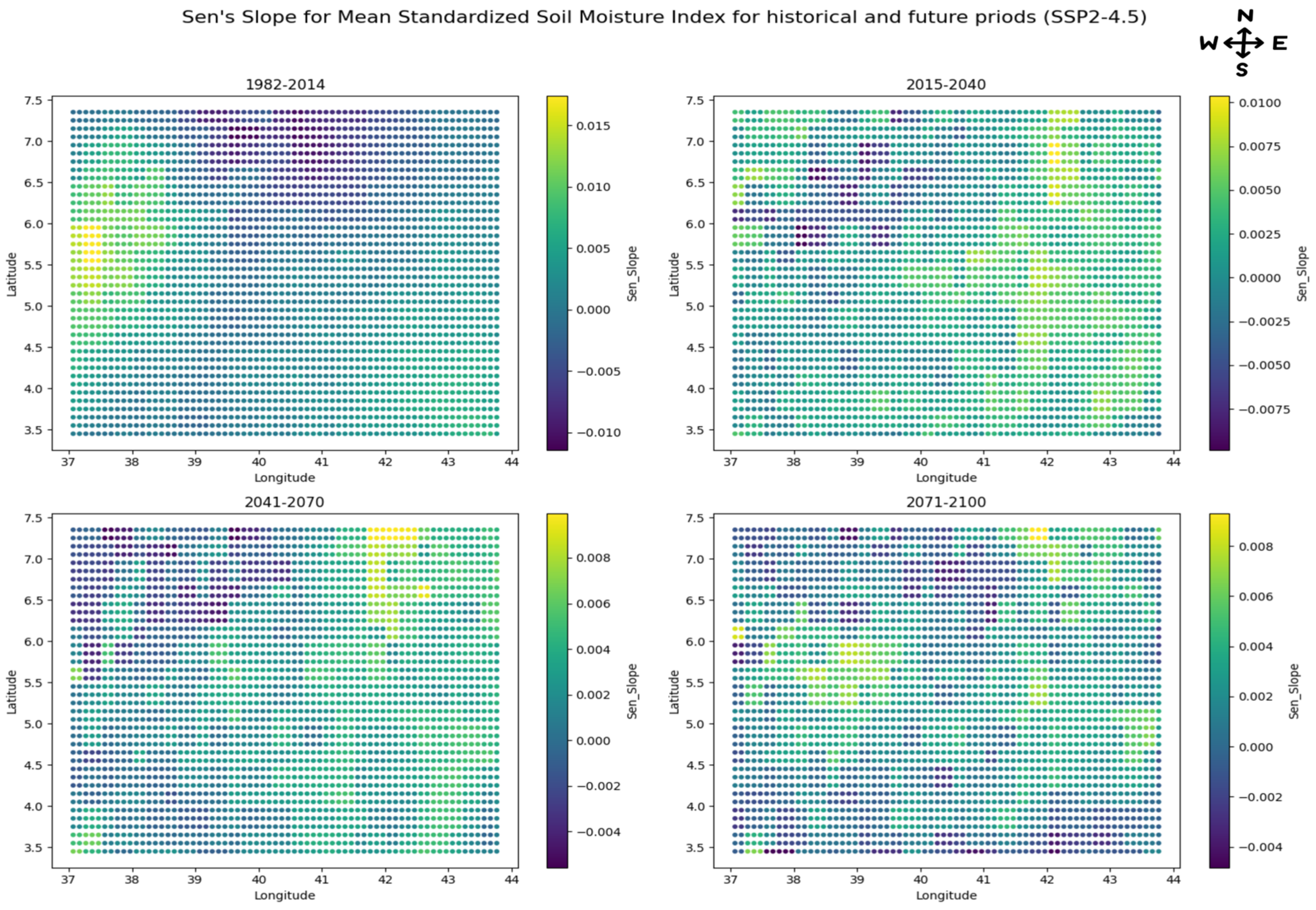




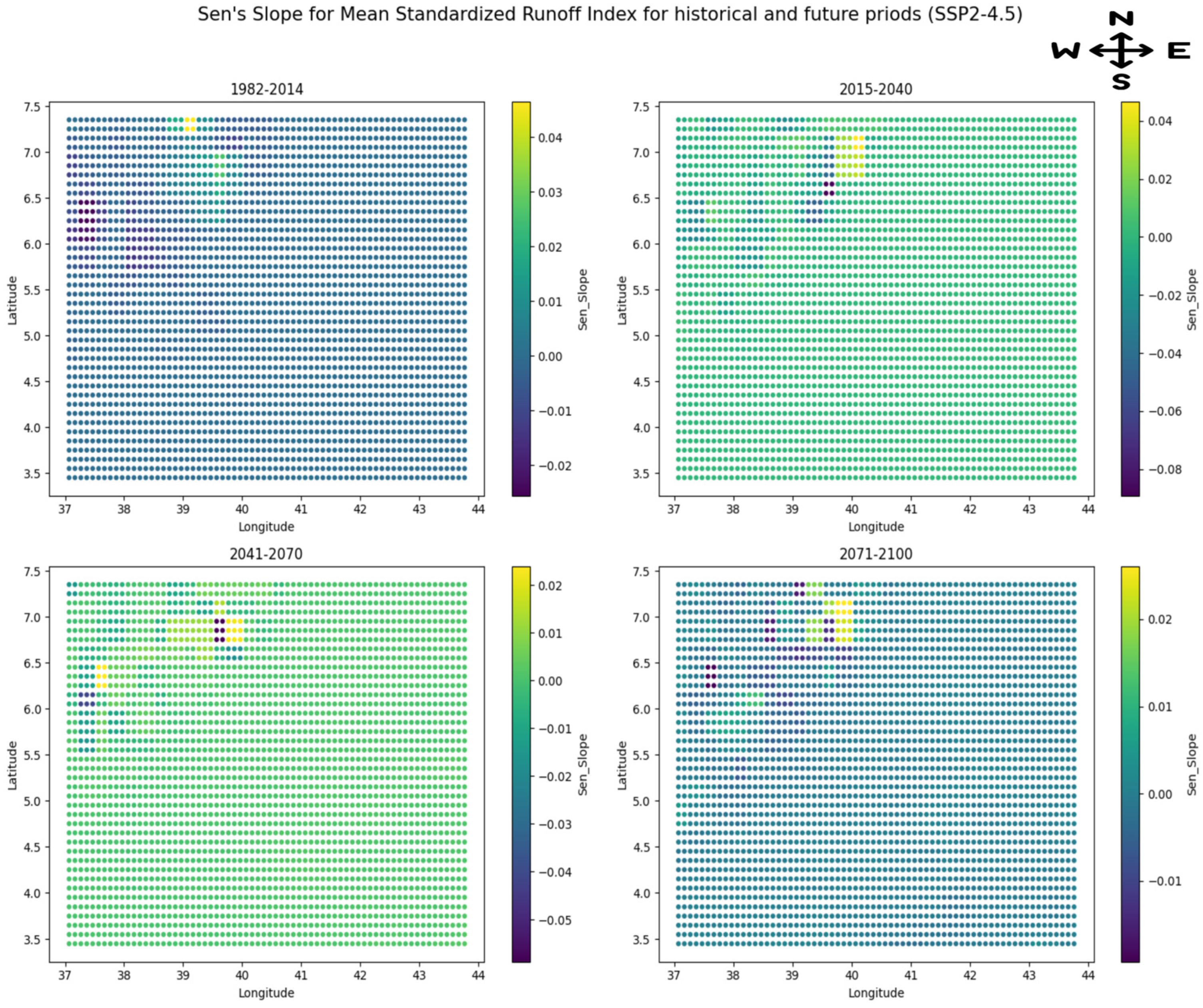
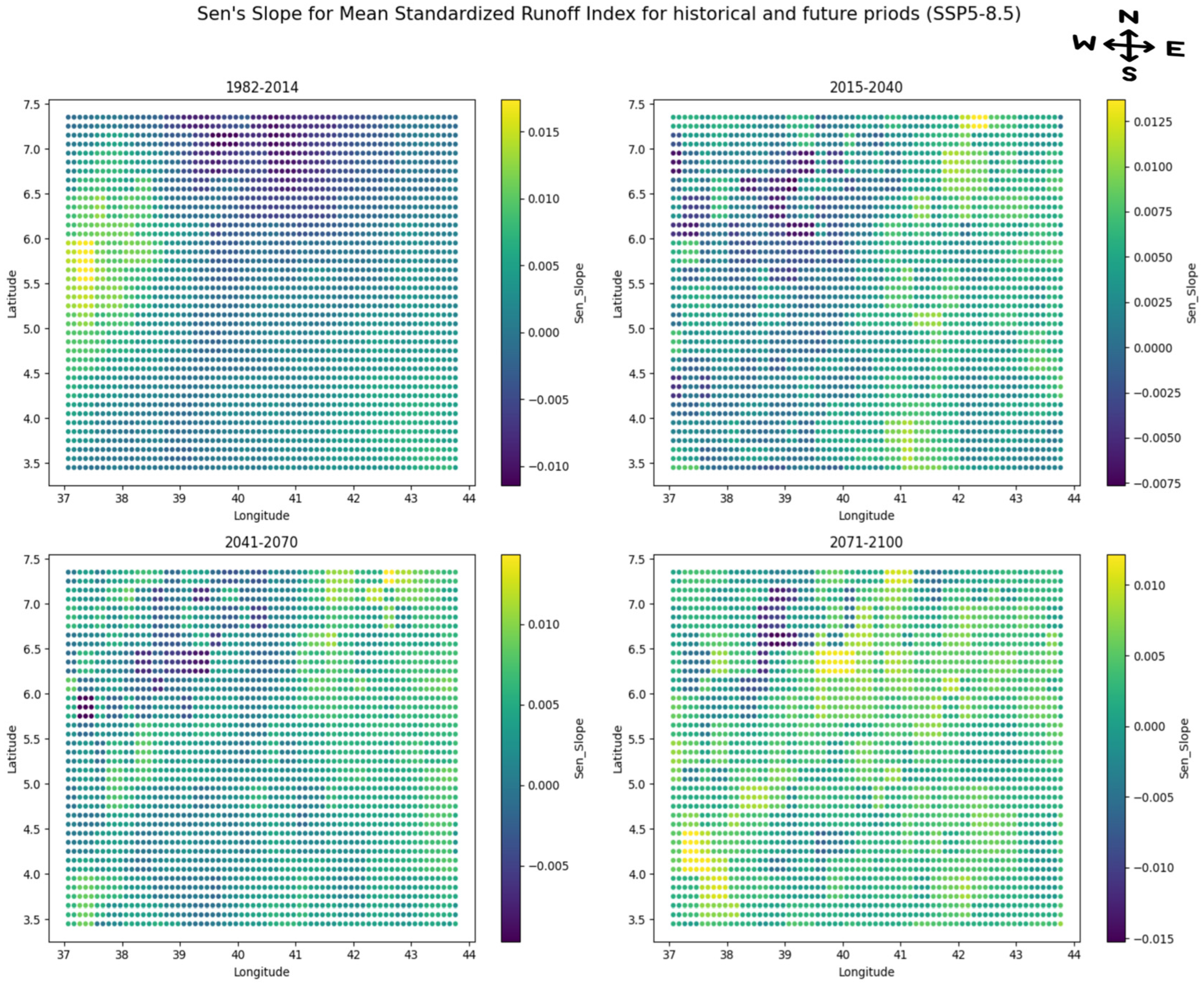
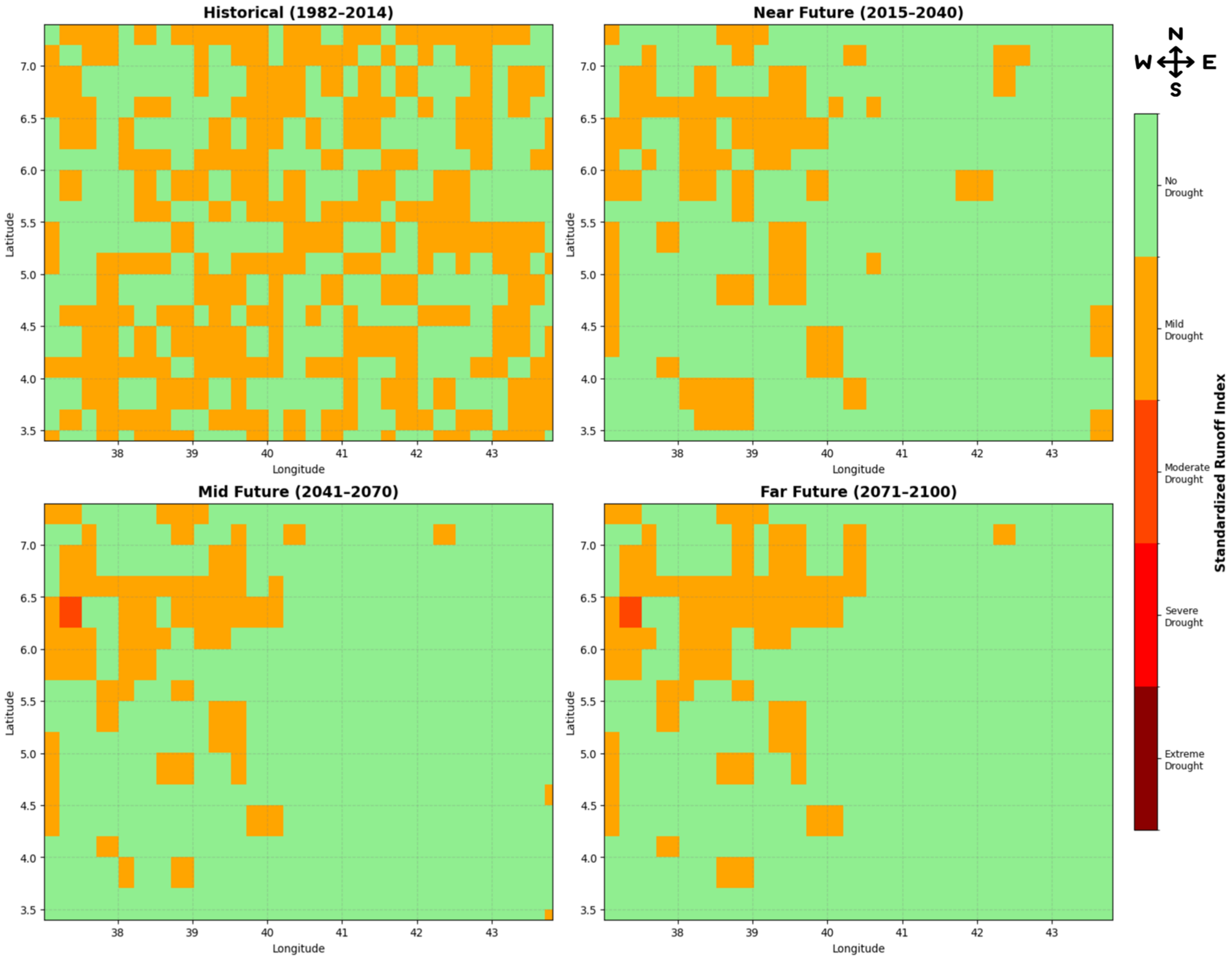


| Dataset | Spatial Resolution | Year | Source |
|---|---|---|---|
| FLDAS | 0.1° (10 × 10 km) | 1982–2014 | NASA’s GES DISC |
| ERA5-Land | 0.1° (10 × 10 km) | 1982–2014 | ECMWF (via CSR-University of Texas, Austin) |
| CHIRPS | 0.05° (5 × 5 km) | 1982–2014 | Climate Hazards Center |
| CHIRTS | 0.05° (5 × 5 km) | 1982–2014 | Climate Hazards Center |
| CMIP6 | 0.27° (30 × 30 km) | 1982–2100 | NASA NCCS-NEX-GDDP CMIP6 |
| Variable | VIF |
|---|---|
| Intercept | 8500.63 |
| Precipitation (mean_pr) | 2.12 |
| Mean temperature (mean_tas) | 1.58 |
| Wind speed (mean_sfcWind) | 1.56 |
| Downward shortwave radiation (mean_rsds) | 1.45 |
| Relative humidity (mean_hurs) | 2.81 |
| Variable | Period | RMSE | R2 | MAE |
|---|---|---|---|---|
| SSMI | Training | 0.0100 | 0.969 | 0.0074 |
| SSMI | Testing | 0.0141 | 0.950 | 0.0094 |
| SRI | Training | 0.0224 | 0.875 | 0.0050 |
| SRI | Testing | 0.0265 | 0.814 | 0.0064 |
| Predictor Variable | Importance Score | |
|---|---|---|
| Agricultural Drought | Hydrological Drought | |
| Precipitation (mm) | 0.602 | 0.186 |
| Relative humidity (%) | 0.150 | 0.139 |
| Air temperature (°C) | 0.098 | 0.411 |
| Surface wind speed (m/s) | 0.081 | 0.148 |
| Shortwave radiation (W/m2) | 0.07 | 0.115 |
| Scenario | Period | Kendall_Tau | Sen_Slope | p_Value |
|---|---|---|---|---|
| His | Baseline | 0.0341 | 0.0024 | 0.7922 |
| SSP245 | NF | 0.1077 | 0.0039 | 0.4536 |
| SSP245 | MF | 0.2598 | 0.0076 | 0.0457 |
| SSP245 | FF | 0.231527 | 0.006063 | 0.081072 |
| SSP585 | NF | 0.193846 | 0.006088 | 0.171758 |
| SSP585 | MF | 0.324138 | 0.014731 | 0.012499 |
| SSP585 | FF | 0.231527 | 0.008072 | 0.081072 |
| Scenario | Period | Frequency | Duration | Severity | Intensity |
|---|---|---|---|---|---|
| His | Baseline | 34 | 1.3235 | 1.7093 | 1.2625 |
| SSP245 | NF | 0 | 0 | 0 | 0 |
| SSP245 | MF | 10 | 1 | 1.117 | 1.117 |
| SSP245 | FF | 16 | 1.1875 | 1.4052 | 1.2034 |
| SSP585 | NF | 33 | 1.4848 | 2.0071 | 1.2799 |
| SSP585 | MF | 2 | 1 | 1.0693 | 1.0693 |
| SSP585 | FF | 19 | 1.1053 | 1.2841 | 1.1722 |
| Scenario | Period | Kendall_Tau | Sen_Slope | p_Value |
|---|---|---|---|---|
| His | Baseline | −0.13258 | −0.00537 | 0.285018 |
| SSP245 | NF | −0.49538 | −0.0109 | 0.000421 |
| SSP245 | MF | −0.18621 | −0.00282 | 0.153498 |
| SSP245 | FF | 0.187192 | 0.00556 | 0.15947 |
| SSP585 | NF | −0.40308 | −0.00683 | 0.004165 |
| SSP585 | MF | −0.14943 | −0.0035 | 0.253526 |
| SSP585 | FF | 0.152709 | 0.003496 | 0.252523 |
| Scenario | Period | Frequency | Duration | Severity | Intensity |
|---|---|---|---|---|---|
| His | Baseline | 31 | 2.8387 | 3.3924 | 1.1909 |
| SSP245 | NF | 26 | 2.1154 | 2.4375 | 1.1551 |
| SSP245 | MF | 35 | 2.5429 | 2.878 | 1.1308 |
| SSP245 | FF | 26 | 2.6923 | 3.0266 | 1.1239 |
| SSP585 | NF | 31 | 2.8387 | 3.3924 | 1.1909 |
| SSP585 | MF | 26 | 2.1154 | 2.4288 | 1.1478 |
| SSP585 | FF | 36 | 2.5556 | 2.8892 | 1.1304 |
Disclaimer/Publisher’s Note: The statements, opinions and data contained in all publications are solely those of the individual author(s) and contributor(s) and not of MDPI and/or the editor(s). MDPI and/or the editor(s) disclaim responsibility for any injury to people or property resulting from any ideas, methods, instructions or products referred to in the content. |
© 2025 by the authors. Licensee MDPI, Basel, Switzerland. This article is an open access article distributed under the terms and conditions of the Creative Commons Attribution (CC BY) license (https://creativecommons.org/licenses/by/4.0/).
Share and Cite
Abdulahi, M.M.; Egli, P.E.; Belayneh, A.; Bamutaze, Y.; Dejene, S.W. Impact of Climate Change on Drought Dynamics in the Ganale Dawa River Basin, Ethiopia. Climate 2025, 13, 231. https://doi.org/10.3390/cli13110231
Abdulahi MM, Egli PE, Belayneh A, Bamutaze Y, Dejene SW. Impact of Climate Change on Drought Dynamics in the Ganale Dawa River Basin, Ethiopia. Climate. 2025; 13(11):231. https://doi.org/10.3390/cli13110231
Chicago/Turabian StyleAbdulahi, Mohammed Mussa, Pascal E. Egli, Anteneh Belayneh, Yazidhi Bamutaze, and Sintayehu W. Dejene. 2025. "Impact of Climate Change on Drought Dynamics in the Ganale Dawa River Basin, Ethiopia" Climate 13, no. 11: 231. https://doi.org/10.3390/cli13110231
APA StyleAbdulahi, M. M., Egli, P. E., Belayneh, A., Bamutaze, Y., & Dejene, S. W. (2025). Impact of Climate Change on Drought Dynamics in the Ganale Dawa River Basin, Ethiopia. Climate, 13(11), 231. https://doi.org/10.3390/cli13110231








